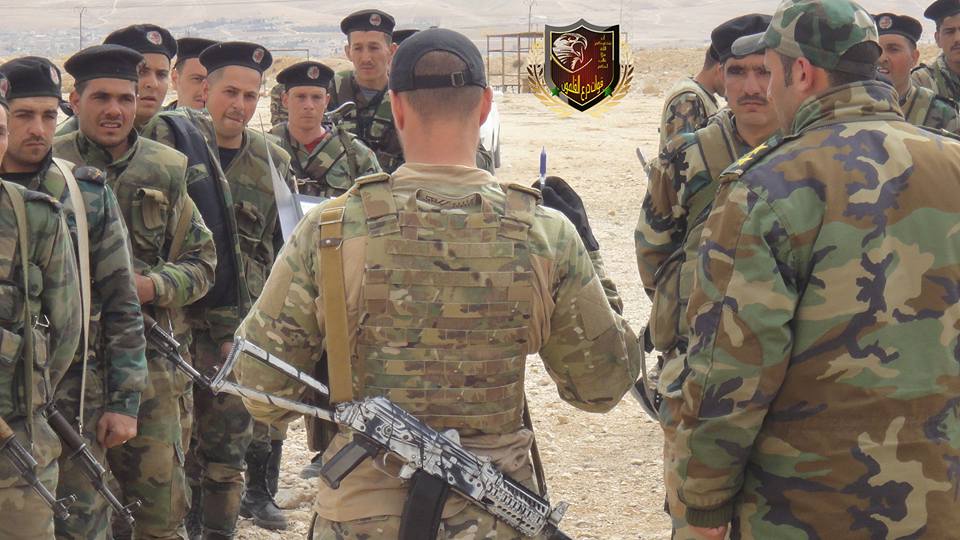
The Qalamoun Shield Forces (QSF) appeared as a noticeable auxiliary force of the Syrian military in the first half of 2016, with the goal of protecting the Al-Qalamoun areas from terrorist threats and securing the Syrian-Lebanese border.
The group includes approximately 2800 fighters, most of whom are volunteers from the eastern towns of Al-Qalamoun, along with a few hundred former fighters from the Free Syrian Army (FSA). A number of FSA fighters had joined the QSF after a reconciliation agreement with the Syrian government.

The QSF is linked to the Third Armored Division of the Syrian Arab Army (SAA), and works with both the Syrian Republican Guard and Lebanese Hezbollah.
The QSF has several bases in Yabroud and Al-Nabak. It’s led by Lieutenant Firas Khaza’a, and mainly funded by the Syrian Ministry of Defense. The QSF is one the groups supported by the Russian military, which armed and trained all of its fighters in the early 2017.
At least a part of the training took place in the Damascus countryside:
The QSF controls a number of important border points in eastern Qalamoun, especially the area of Flitah, near the Lebanese area of Jurod Arsal, the stronghold of ISIS militants. It has managed along with the Syrian Republican Guard and Hezbollah to repel several attacks of Hay’at Tahrir al-Sham (HTS) in the vicinity of Flitah.
The QSF has also foiled several infiltration attempts between Lebanon and Syria, as well as prevented several drug smuggling operations, which are often considered means of financing terrorist groups in the Lebanese area of Jurod Arsal.
In 2017, the QSF participated in its first battle outside eastern Al-Qalamoun area. In the middle of March 2017, QSF units deployed to the Hama front, where QSF participated in repelling the second joint attack of HTS, Jaish al-Izza and other militant groups on the strategic town of Qomhana in the northern Hama countryside.
The QSF continued its operations alongside the SAA’s Tiger Forces, the National Defense Forces and other pro-government groups and took part in restoring control of Khattab village on March 31, Mahardeh village on April 11, Souran on April 16, the towns of Taibat al-Imam and Halfaya on April 22 and 23. Then the QSF took part in capturing the Al-Zalaqiat village and hill. In case of continuation of clashes in northern Hama, the QSF will likely participate in future government attacks aimed at capturing Morek and Lataminah.
In May 2017, a part of QSF fighters were redeployed from northern Hama to the province of Homs in order to participate in a widely-expected government advane on the city of Deir Ezzor besieged by ISIS.
In early April 2017, a new pro-government group appeared in the Syrian-Lebanese border area, “The Homeland Shield Forces – Special Tasks”. The force consists of 400 fighters from 14 Lebanese villages from the Al-Beka’a area on the Syrian-Lebanese border. It is led by al-Haj Muhammad Jaafar and was founded with the direct support of the Russian military to secure the Al-Beka’a area.
The force may work in the future with the QSF in an expected operation to secure the Syrian side of Jurod Arsal in order to prevent any terrorists infiltrating the Syrian territory in case the Lebanese Army launches an operation against ISIS and HTS militants in the region.
The QSF is armed with medium weapons, such as vehicles armed with 23/14.5 guns; it is also armed with Konkurs ATGM. The forces also use heavy Syrian Bourkan(Volcano)-type rockets.
The QSF is a successful example of a rapid reaction force protecting the Syrian border and has proven that it can support the SAA in any area when necessary. The forces have carried out offensive and defensive missions in the northern Hama countryside very successfully. It could be expected that its financing and fighter numbers will be expanded if the joint Syrian, Iranian, Russian and Turkish efforts aimed at imposing ‘de-escalation zones’ will not been able to launch a successful peace process in Syria.
The further expansion of the QSF and other QSF-style groups, that would include former “moderate rebels”, will be clearly linked to a possibility of the Syrian government and its allies to implement their reconciliation agreements strategy in the countryside of Damascus and across Syria.










